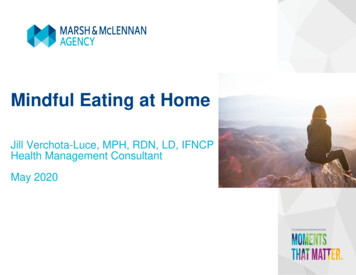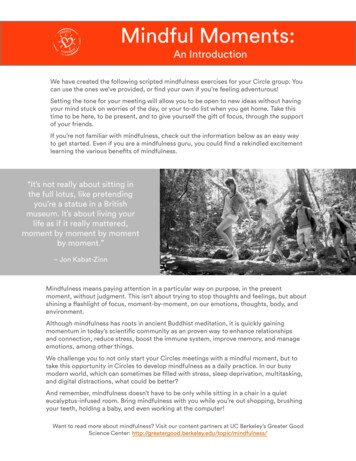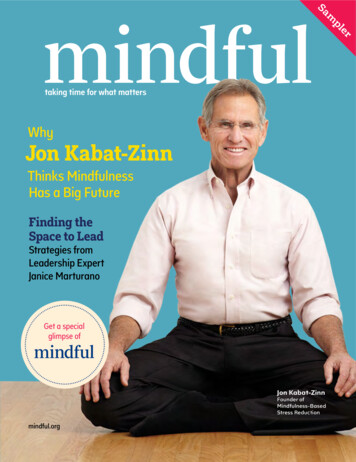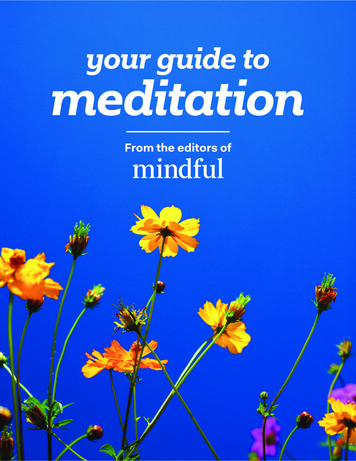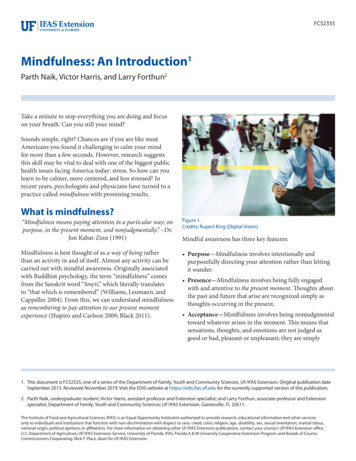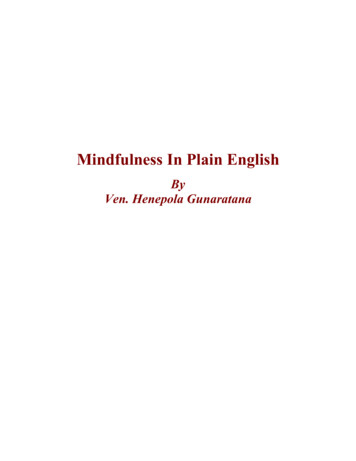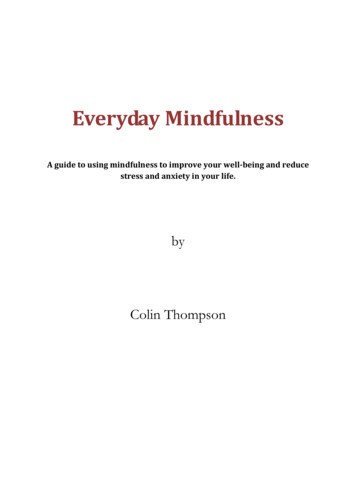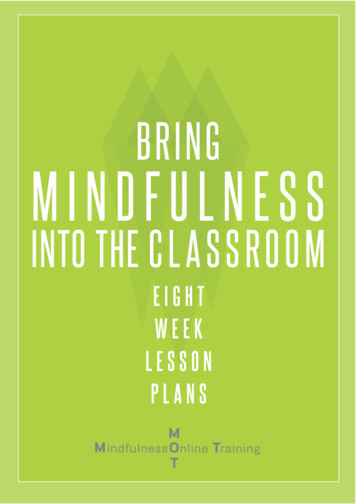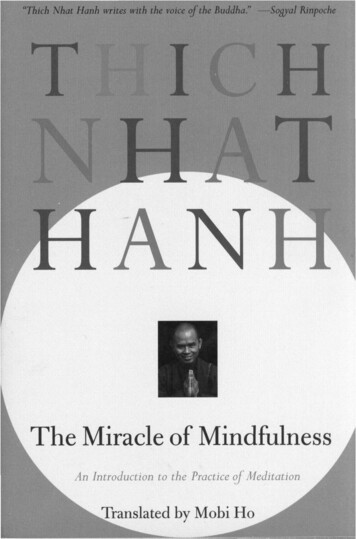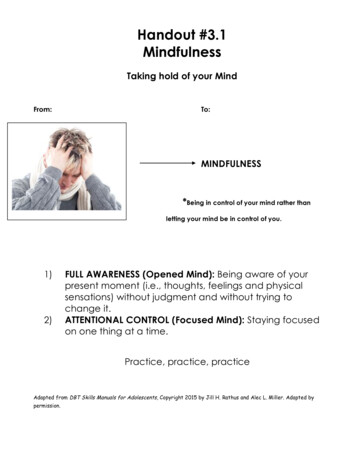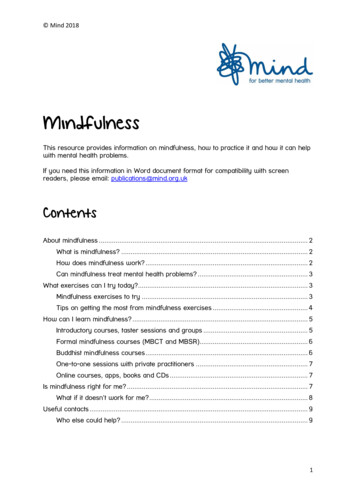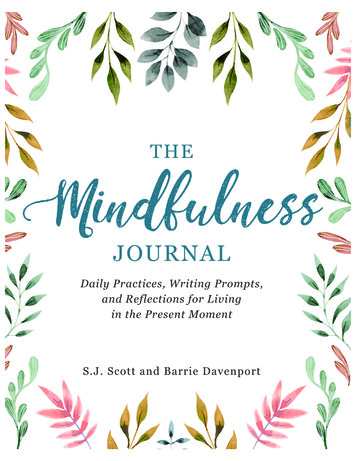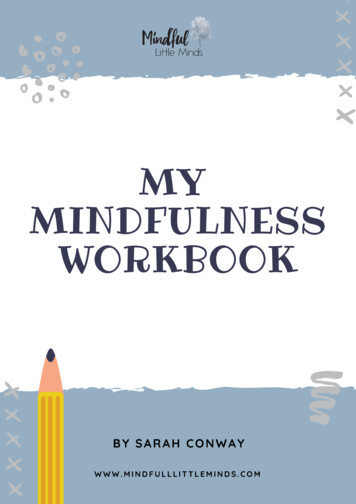
Transcription
MYMINDFULNESSWORKBOOKBY SARAH CONWAYWWW.MINDFULLLITTLEMINDS.COM
CONTENTS1. Introduction to mindfulness (forparents)2. Tips for introducing mindfulness tochildren3. What is mindfulness?4. Mindful breathing5. Mindful listening6. Mind jars7. Mindful colouring9. Mindful playWWW.MINDFULLLITTLEMINDS.COM
INTRODUCTION TOMINDFULNESSMindfulness is the act of paying purposeful attention to thepresent, in a non judgmental way. It is being fully presentin the moment. This means that we notice our thoughts,feelings, physical sensations and the environment aroundus, without labelling them as "good" or "bad". We simplyaccept our experience as it is. This can be very powerful,particularly when it comes to our thoughts and feelings, asit allows us to notice them without reacting rashly. Whenwe simply allow these internal experiences to occur andbecome aware of them, rather than feeling controlled bythem, we are better able to respond to situations andchallenges in a thoughtful, measured way.Benefits of mindfulness for children include:Increased self esteemReduced symptoms of depression and anxietyImproved sleepImproved impulse controlEncouragement of positive behaviours such as empathy andoptimismIncreased emotional intelligenceReduced aggression and better conflict resolutionImproved resilienceImproved classroom learningWWW.MINDFULLLITTLEMINDS.COM1
TIPS FOR USING THISWORKBOOKThe activities in this book are a fun and engaging way tointroduce mindfulness to your child, and even very youngchildren will get some benefit from them.They are designed to help children be more aware: oftheir bodies, their feelings, their thoughts, and theirenvironment, and to live more fully in the presentmoment.You'll find that most of them can be completed justabout anywhere, and are quite quick - perfect for young,busy minds and wriggly bodies.When introducing mindfulness to kids for the first time,use simple language. When I speak to children aboutmindfulness, I talk about "noticing". Explain that you willbe noticing how your body feels, what is happeningaround you, or what your thoughts are doing.Keep it short! 5-10 minutes, max! Any longer than thatand you may find kids get frustrated and switch off.Don't push it. If your child isn't really interested rightnow, that's ok. Waiting until they are eager to learn willbring them (and you!) better results anyway!Sometimes the best way to explain mindfulness tochildren is simply to show them. Jump in and do theseexercises with the kids. You may even learn somethingyourself!WWW.MINDFULLLITTLEMINDS.COM2
WHAT IS MINDFULNESS?Mindfulness is paying attention to what is happening rightnow. When we are mindful, we are noticing how our bodyfeels, what we are thinking, and what is happening aroundus. We pay attention to things like sounds, smells, thingswe can see and things we can touch, as well as feelingsinside our bodies, like rumbling tummies or racing hearts.Sometimes while we're doing things, our minds get a bitdistracted and wander off - do you sometimes start todaydream during class? Or do you get caught thinkingabout what you're going to have for lunch when your mumis asking you a question? Yep, me too! Oops!Thats ok though - minds can be a bit funny like that! Whenwe notice that our mind is wandering, we're just going togive it a bit of a nudge and remind it to pay attention towhat we're doing!Mindfulness can be really helpful for us. It can help us feelcalm, worry less, sleep better and pay attention in class.And, it's fun too! Let's try some activities now so you cansee for yourself, ok?WWW.MINDFULLLITTLEMINDS.COM3
STAR BREATHINGPaying attention to your breathing can help you calm downwhen you are feeling upset. Trace your finger slowlyaround the star, following the instructions. Breathe inthrough your nose and fill your belly with air, like aballoon. Hold your breath at the point of the star. Thenbreathe out through your mouth so your belly is flat nBreatheHoldHoldBreatheetheaBrBreathe outHolde outBreathBreathe inHoldldHoWWW.MINDFULLLITTLEMINDS.COM4
MINDFUL LISTENINGSometimes paying attention to things we can hear is a biteasier than paying attention to our breathing. Let's try itnow:Sit down in a comfortable spot and be nice and still. Take afew deep breaths in through your nose and out throughyour mouth. Now listen.I want you to pay attention to all the different sounds youcan hear.What did you hear? Can you write them down or draw themhere?WWW.MINDFULLLITTLEMINDS.COM5
MIND JARMind jars are great at helping us calm down. Sometimeswhen we are upset, our thoughts swirl around in our heads,just like the glitter when we shake the jar. But if we sitquietly for a few moments, and just watch the glitter, itstarts to settle and calm down, and so do our thoughts! Doyou want to make one?What you need:Glass jar or plastic bottle with a lidGlitter glueWaterHot glue gunWhat to do:Fill your jar or bottle most of the way with waterAdd two big spoonfuls of glitter glueFeel free to add extra glitter or sparkly sequins if you like!Use the hot glue gun to glue the lid back on so it doesn't spillShake it all around!WWW.MINDFULLLITTLEMINDS.COM6
MINDFUL COLOURINGWhen you do mindful colouring, you focus only on what youare doing. You may find it helpful to talk to yourself aboutwhat you're doing. You might say, "Now I am colouring withthe red pencil." Don't worry about whether your colouringis "good" or "bad". Just colour!WWW.MINDFULLLITTLEMINDS.COM7
MINDFUL COLOURINGWhen you do mindful colouring, you focus only on what youare doing. You may find it helpful to talk to yourself aboutwhat you're doing. You might say, "Now I am colouring withthe red pencil." Don't worry about whether your colouringis "good" or "bad". Just colour!WWW.MINDFULLLITTLEMINDS.COM8
MINDFUL PLAY IDEASMindfulness can be lots of fun! Here are some games forparents and kids to play together while they practice theirmindfulness skills!Blowing Bubbles: This is a fun way to practice mindfulbreathing! Breathe in deeply through your nose, and thenbreathe out slowly through your mouth as you form thebubbles. Focus your attention on the bubbles as they floataway. {If your child is too young to blow bubbles, blowthem yourself and have your child pay close attention tothe bubbles being made, and then floating away}Taste Test: Grab an assortment of yummy foods that youknow your child will like. Blindfold them and have themexplore the food using all their other senses: touch, smell,taste, hearing. See if they can guess the food!Balloon Fun: Try to keep the balloon in the air! This is agreat way to involve the whole body in a mindfulnessactivity, as well as the mind as you focus your attention onkeeping the balloon afloat!What am I: Grab a bag/box/bowl and a collection of itemswith different textures, like sticks, leaves, rocks, a soft toy,a washcloth etc. Without looking or removing them fromthe bag, have your child reach in and explore the objectswith their hands. Ask them to describe the object and try toguess what it is!WWW.MINDFULLLITTLEMINDS.COM9
ABOUT THE AUTHORSARAH CONWAYSarah is a psychologist, mama of 4 and founder of MindfulLittle Minds: an online marketplace, blog and community ofparents and educators dedicated to building resilient kids,calm homes and connected families.She is passionate about the mental health of children andteenagers and has over 10 years of experience workingwith and helping, children and families affected by mentalillness.Sarah has been practicingmindfulness herself for almost 15years now. This workbook is acollection of some of her favouriteactivities for children.In her spare time Sarah enjoyshanging out with her kids, drinkingcoffee, and binge watchingBrooklyn Nine-Nine on Netflix.FOR MORE MINDFULNESS RESOURCES,INFORMATION, TIPS AND STRATEGIES, VISITMINDFUL LITTLE MINDS HERE:WWW.MINDFULLLITTLEMINDS.COM
Mindfulness is the act of paying purposeful attention to the present, in a non judgmental way. It is being fully present in the moment. This means that we notice our thoughts, feelings, physical sensations and the environment around us, without labelling them as "good" or "bad". We simply accept our experience as it is. This can be very powerful, particularly when it comes to our thoughts and .
